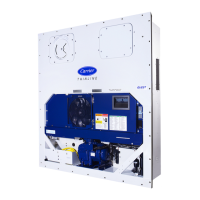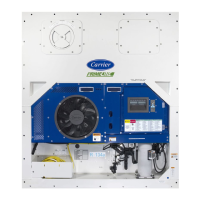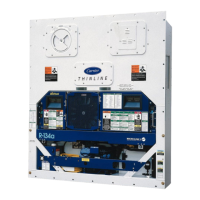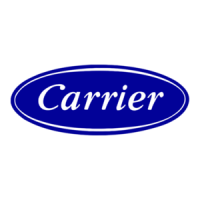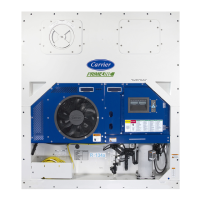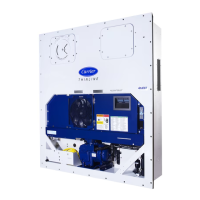6–7 T-319
8. Repeat steps 5. and 6. one time.
9. Remove the copper tubing and change the filter-drier. Evacuate unit to 500 microns. Close the electronic
vacuum gauge and vacuum pump valves. Shut off the vacuum pump. Wait five minutes to see if vacuum
holds. This procedure checks for residual moisture and/or leaks.
10. With a vacuum still in the unit, the refrigerant charge may be drawn into the system from a refrigerant con-
tainer on weight scales. Continue to Section 6.7.
6.6.4 Procedure - Partial System
1. If the refrigerant charge has been removed from the compressor for service, evacuate only the compressor
by connecting the evacuation set-up at the compressor service valves. Follow evacuation procedures of the
preceding paragraph except leave compressor service valves frontseated until evacuation is completed.
2. If refrigerant charge has been removed from the low side only, evacuate the low side by connecting the
evacuation set-up at the compressor suction service valve and liquid service valve except leave the service
valves frontseated until evacuation is completed.
3. Once evacuation has been completed and the pump has been isolated, fully backseat the service valves to
isolate the service connections and then continue with checking and, if required, adding refrigerant in accor-
dance with normal procedures.
6.7 REFRIGERANT CHARGE
6.7.1 Checking the Refrigerant Charge
To avoid damage to the earth’s ozone layer, use a refrigerant recovery system whenever removing
refrigerant. When working with refrigerants you must comply with all local government environmental
laws. In the U.S., refer to EPA section 608.
1. Connect the gauge manifold to the compressor discharge and suction service valves.
2. Bring the container temperature to approximately 1.7°C (35°F) or -17.8°C (0°F). Set the host controller set
point to -25°C (-13°F) to ensure that the suction modulation valve is at maximum allowed open position.
3. Partially block the condenser coil inlet air. Increase the area blocked until the compressor discharge pres-
sure is raised to approximately 12 kg/cm
2
(175 psig).
4. On units equipped with a receiver, the level should be between the glasses. If the refrigerant level is not cor-
rect, continue with the following paragraphs to add or remove refrigerant as required.
6.7.2 Adding Refrigerant to System (Full Charge)
1. Evacuate unit and leave in deep vacuum (refer to Section 6.6).
2. Place cylinder of R-134a on scale and connect charging line from cylinder to liquid line valve. Purge
charging line at liquid line valve and then note weight of cylinder and refrigerant.
3. Open liquid valve on cylinder. Open liquid line valve half-way and allow the liquid refrigerant to flow into the
unit until the correct weight of refrigerant (refer to Section 2.4) has been added as indicated by scales.
It may be necessary to finish charging unit through suction service valve in gas form, due to pressure
rise in high side of the system (refer to section Section 6.7.3).
4. Backseat manual liquid line valve (to close off gauge port). Close liquid valve on cylinder.
5. Start unit in cooling mode. Run approximately 10minutes and check the refrigerant charge.
6.7.3 Adding Refrigerant to System (Partial Charge)
1. Examine the unit refrigerant system for any evidence of leaks. Repair as necessary (refer to Section 6.5).
2. Maintain the conditions outlined in Section 6.7.1.
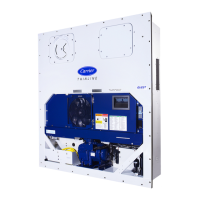
